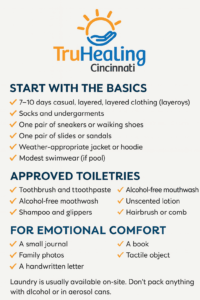There’s no guidebook for this moment.
No one tells you what it feels like to pack a bag for your child to go to treatment—not a vacation, not college, not a sleepover with friends. This is different. You’re folding sweatpants and socks with shaky hands, hoping what you send helps, and wondering if you’re doing it “right.”
If your young adult is heading into a residential treatment program in Cincinnati, this blog is here to help. Not just with the logistics—but with the real stuff underneath. Because we know what this season feels like.
Start with the Basics They’ll Actually Use
A residential treatment stay isn’t about appearances. Comfort and practicality are key. While each program may provide its own list, here’s a good starting point:
- 7–10 days of casual, comfortable clothing (layers work well)
- Sleepwear and slippers
- Socks and undergarments
- One pair of sneakers or walking shoes
- One pair of slides or sandals for shower use
- Weather-appropriate jacket or hoodie
- Modest swimwear (if pools or wellness activities are available)
Laundry is typically available on-site, so packing light but functional is encouraged. Don’t overthink fashion—this isn’t about self-presentation. It’s about self-preservation.
Toiletries: Approved, Simple, Safe
Most residential treatment programs have restrictions on personal care products to avoid safety risks or contraband. Always check the facility’s guidelines, but in general:
✅ DO pack:
- Toothbrush and toothpaste
- Alcohol-free mouthwash
- Shampoo and conditioner
- Body wash or bar soap
- Unscented lotion or moisturizer
- Hairbrush or comb
- Feminine hygiene products
🚫 AVOID:
- Aerosol sprays or pressurized cans
- Products with alcohol listed as a primary ingredient
- Perfumes or heavily scented lotions
- Nail clippers, tweezers, or razors (unless approved in advance)
Keep everything simple, fragrance-free, and non-glass.
What to Pack for Emotional Comfort
This is one of the most overlooked—but essential—parts of packing.
Recovery is vulnerable. It’s disorienting. Your loved one may go from total silence to sobbing in a group session they didn’t think they’d ever attend. They’ll need anchors—reminders of who they are outside the pain.
Consider including:
- A small journal or notebook
- A favorite paperback book
- Printed family photos
- A short handwritten letter (yes, it matters)
- Something tactile and safe, like a fidget item or calming object
Leave the phone behind (most programs don’t allow them during active treatment), but send pieces of love that don’t require charging.
Medications and Documentation
Bring all prescription medications in original, pharmacy-labeled bottles. Write down:
- Medication names
- Dosages and timing
- Any known allergies
- Contact info for prescribing doctors
Most facilities will have a nurse or medical professional oversee medication storage and administration. DO NOT send over-the-counter meds unless explicitly approved.

Leave These at Home
Some items, while sent with good intentions, are not allowed in residential care. Here’s what to leave out:
- Outside food or drinks
- Sharp items (razors, scissors, tweezers)
- Weapons or anything that could be improvised as one
- Revealing clothing or anything with profanity/substance references
- Vapes, tobacco products, lighters, or CBD
These rules exist for everyone’s safety and comfort. Even if your loved one insists they “need” it, trust the structure. Safety makes connection possible.
Don’t Forget Yourself: A Packing List for Parents
While your child is in care, you’re doing your own emotional work on the outside.
You may not be staying with them—but you’re holding space, fielding questions from family, second-guessing yourself, and wondering what comes next.
Take time to gather your own support items:
- Names and contacts of their care team
- Access to a parent or family support group
- Journal for your thoughts
- A short list of people who get it—the ones you can call without explaining everything
- A small ritual to ground you (even just lighting a candle, walking daily, praying)
If you’re in Lexington, Kentucky or Springfield, Ohio, TruHealing offers resources and referrals for family support in your area.
FAQs: What Parents Want to Know About Packing for Residential Treatment
How much can I pack?
Most programs recommend one suitcase or duffel bag. Storage space is limited. Think capsule wardrobe, not full closet.
Can I send care packages later?
Yes—once your loved one is settled, you can often send approved items. Always check with staff first for what’s allowed.
Can they bring their phone or tablet?
Usually no, especially during the initial phase of treatment. This helps them stay focused and fully present.
What happens if I forget something?
Most programs have essentials available or can work with families to get needed items delivered. Don’t stress over perfection.
Can I write letters or visit?
Yes—but timing varies. Some programs include family weekends or therapeutic visitation schedules. Ask your loved one’s care team about the plan.
This Bag Is Not Goodbye
Here’s what you need to know most: This isn’t the end. It’s not a sentence. It’s a beginning you never imagined making—but here you are.
Every folded T-shirt is a whisper: You are loved. You are worth this effort. You are not alone.
You don’t have to pack it all perfectly. Just lovingly.
Ready to Talk?
Call (888) 643-9118 to learn more about our residential treatment program services in Cincinnati, Ohio. Whether you’re supporting your teen or young adult, we’re here to walk this next step with you.


